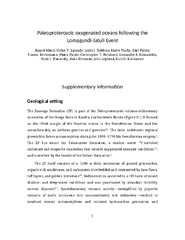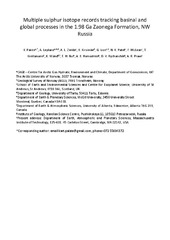Blar i forfatter "Paiste, Kärt"
-
Chromium evidence for protracted oxygenation during the Paleoproterozoic
Mänd, Kaarel; Planavsky, Noah J.; Porter, Susannah M.; Robbins, Leslie J.; Wang, Changle; Kreitsmann, Timmu; Paiste, Kärt; Paiste, Päärn; Romashkin, Alexander E.; Deines, Yulia E.; Kirsimäe, Kalle; Lepland, Aivo; Konhauser, Kurt O. (Journal article; Tidsskriftartikkel; Peer reviewed, 2022-03-24)It has commonly been proposed that the development of complex life is tied to increases in atmospheric oxygenation. However, there is a conspicuous gap in time between the oxygenation of the atmosphere 2.4 billion years ago (Ga) and the first widely-accepted fossil evidence for complex eukaryotic cells . At present the gap could either represent poor sampling, poor preservation, and/or difficulties ... -
Constraining the conditions of phosphogenesis: Stable isotope and trace element systematics of Recent Namibian phosphatic sediments
Lumiste, Kaarel; Mänd, Kaarel; Bailey, Jake; Stüeken, Eva E.; Paiste, Kärt; Lang, Liisa; Sepp, Holar; Lepland, Aivo; Kirsimäe, Kalle (Journal article; Tidsskriftartikkel; Peer reviewed, 2021-03-31)Modern phosphogenesis occurs on continental margins influenced by upwelling and high primary productivity. The formation of phosphatic sediments is coupled to global climate fluctuations, biological cycling of phosphorus and local redox conditions. Although the processes involved in phosphogenesis are well described, high-resolution data on the redox and stable isotope systematics in Recent in-situ ... -
Hydrothermal dedolomitisation of carbonate rocks of the Paleoproterozoic Zaonega Formation, NW Russia — Implications for the preservation of primary C isotope signals
Kreitsmann, Timmu; Külaviir, Marian; Lepland, Aivo; Paiste, Kärt; Paiste, Päärn; Prave, Anthony R.; Sepp, Holar; Romashkin, Alexander E; Rychanchik, Dmitry V.; Kirsimäe, Kalle (Journal article; Tidsskriftartikkel; Peer reviewed, 2019-03-03)The Paleoproterozoic Zaonega Formation in Karelia, NW Russia, has played a key role in understanding the environmental conditions postdating the Great Oxidation and Lomagundi-Jatuli Events. Its carbonate- and organic-rich rocks (shungite) define the postulated Shunga Event representing an accumulation of very organic-rich sediments at c. 2 Ga and are central in ideas about changing ocean-atmosphere ... -
Identifying global vs. basinal controls on Paleoproterozoic organic carbon and sulfur isotope records
Paiste, Kärt; Lepland, Aivo; Zerkle, Aubrey L.; Kirsimae, Kalle; Kreitsmann, Timmu; Mänd, Kaarel; Romashkin, Alexander E.; Rychanchik, Dimitry V.; Prave, Anthony R (Journal article; Tidsskriftartikkel; Peer reviewed, 2020-06-03)Paleoproterozoic sedimentary successions are important archives of the redox evolution of Earth’s atmosphere and oceans. Efforts to unravel the dynamics of our planet’s early oxygenation from this archive rely on various geochemical proxies, including stable carbon and sulfur isotopes. However, ancient metasedimentary rocks often experienced early- and late-stage (bio)geochemical processes making ... -
Iron Isotopes Reveal a Benthic Iron Shuttle in the Palaeoproterozoic Zaonega Formation: Basinal Restriction, Euxinia, and the Effect on Global Palaeoredox Proxies
Mänd, Kaarel; Lalonde, Stefan V.; Paiste, Kärt; Thoby, Marie; Lumiste, Kaarel; Robbins, Leslie J.; Kreitsmann, Timmu; Romashkin, Alexander E.; Kirsimäe, Kalle; Lepland, Aivo; Konhauser, Kurt O. (Journal article; Tidsskriftartikkel; Peer reviewed, 2021-03-31)The Zaonega Formation in northwest Russia (~2.0 billion years old) is amongst the most complete successions that record the middle of the Palaeoproterozoic era. As such, geochemical data from the formation have played a central role in framing the debate over redox dynamics in the aftermath of the Great Oxidation Event (GOE). However, uncertainty over local redox conditions and the degree of ... -
Multiple sulphur isotope records tracking basinal and global processes in the 1.98 Ga Zaonega Formation, NW Russia
Paiste, Kärt; Lepland, Aivo; Zerkle, A.L.; Kirsimäe, Kalle; Izon, G.; Patel, N.K.; McLean, F.; Kreitsmann, T.; Mänd, Kaarel; Bui, T.H.; Romashkin, Alexander E.; Rychanchik, Dimitry V.; Prave, Anthony R (Journal article; Tidsskriftartikkel; Peer reviewed, 2018-09-19)The exceptionally organic-rich rocks of the 1.98 Ga Zaonega Formation deposited in the Onega Basin, NW Russia, have refined our understanding of Earth System evolution during the Paleoproterozoic rise in atmospheric oxygen. These rocks were formed in vent- or seep influenced settings contemporaneous with voluminous mafic volcanism and contain strongly <sup>13</sup>C-depleted organic matter. ... -
Oxygenated conditions in the aftermath of the Lomagundi-Jatuli Event: The carbon isotope and rare earth element signatures of the Paleoproterozoic Zaonega Formation, Russia
Kreitsmann, T.; Lepland, Aivo; Bau, M.; Prave, A.R.; Paiste, Kärt; Mänd, K.; Sepp, H.; Martma, T.; Romashkin, A.E; Kirsimäe, K. (Journal article; Tidsskriftartikkel; Peer reviewed, 2020-07-09)The c. 2.0 Ga Zaonega Formation of the Onega Basin (NW Russia) has been central in efforts to understand what led to the initial rise (Great Oxidation Event, GOE) and postulated fall in free atmospheric oxygen and associated high-amplitude carbon cycle excursions, the Lomagundi-Jatuli Event (LJE) and subsequent Shunga Event during Paleoproterozoic time. The Formation accumulated shortly after the ... -
Palaeoproterozoic oxygenated oceans following the Lomagundi–Jatuli Event
Mänd, Kaarel; Lalonde, Stefan V.; Robbins, Leslie J.; Thoby, Marie; Paiste, Kärt; Kreitsmann, Timmu; Paiste, Päärn; Reinhard, Christopher T.; Romashkin, Alexandr E.; Planavsky, Noah J.; Kirsimäe, Kalle; Lepland, Aivo; Konhauser, Kurt O. (Journal article; Tidsskriftartikkel; Peer reviewed, 2020-03-16)The approximately 2,220–2,060 million years old Lomagundi–Jatuli Event was the longest positive carbon isotope excursion in Earth history and is traditionally interpreted to reflect an increased organic carbon burial and a transient rise in atmospheric O<sub>2</sub>. However, it is widely held that O<sub>2</sub> levels collapsed for more than a billion years after this. Here we show that black shales ... -
The pyrite multiple sulfur isotope record of the 1.98 Ga Zaonega Formation: Evidence for biogeochemical sulfur cycling in a semi-restricted basin
Paiste, Kärt; Pellerin, André; Zerkle, A.L.; Kirsimäe, K.; Prave, A.R.; Romashkin, A.E; Lepland, Aivo (Journal article; Tidsskriftartikkel; Peer reviewed, 2020-01-21)The pyrite sulfur isotope record of the 1.98 Ga Zaonega Formation in the Onega Basin, NW Russia, has played a central role in understanding ocean-atmosphere composition and inferring worldwide fluctuations of the seawater sulfate reservoir during the pivotal times of the Paleoproterozoic Era. That, in turn, has led to a concept that Earth's atmospheric oxygen levels underwent global-scale changes. ... -
Reconstructing the Paleoproterozoic sulfur cycle: Insights from the multiple sulfur isotope record of the Zaonega Formation, Karelia, Russia
Paiste, Kärt (Doctoral thesis; Doktorgradsavhandling, 2018-11-08)Earth’s oxygen-rich atmosphere and its capacity to sustain complex life is the most paramount feature that distinguishes Earth from all other planets. The irreversible oxygenation of atmosphere occurred about half way through Earth’s history at ~2.3 Ga (the Great Oxidation Event – GOE) when for the first-time photosynthetic oxygen production surpassed the consumption by chemical reactions allowing ... -
Two-billion-year-old evaporites capture Earth’s great oxidation
Blättler, C.L.; Claire, M.W.; Prave, A.R.; Kirsimäe, K.; Higgins, J.A.; Medvedev, P.V.; Romashkin, A.E; Rychanchik, D.V.; Zerkle, A.L.; Paiste, Kärt; Kreitsmann, T.; Millar, I.L.; Hayles, J.A.; Bao, H.; Turchyn, A.V.; Warke, M.R.; Lepland, Aivo (Journal article; Tidsskriftartikkel; Peer reviewed, 2018-04-20)Major changes in atmospheric and ocean chemistry occurred in the Paleoproterozoic era (2.5 to 1.6 billion years ago). Increasing oxidation dramatically changed Earth’s surface, but few quantitative constraints exist on this important transition. This study describes the sedimentology, mineralogy, and geochemistry of a 2-billion-year-old, ~800-meter-thick evaporite succession from the Onega Basin in ...


 English
English norsk
norsk









